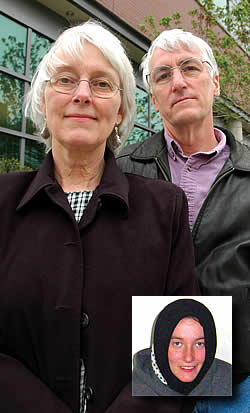The parents of Rachel Corrie somehow appear more ordinary than I had expected: smiling, gray-haired, and unassuming. But after settling into our seats at a Central District Starbucks, Craig at times stares forlornly into the distance and Cindy pours forth with impassioned memories. Its clear that the extraordinary circumstances of their daughters death three years ago have consumed them. As the world now knows, their 23-year-old daughter, an Evergreen State College student, died while defending a Palestinian home from demolition by the Israeli Defense Forces (IDF). A bulldozer killed her. It took over my life, says 58-year-old Cindy, a onetime flautist who, like her husband, wears a green plastic bracelet with the dates of Rachels birth and death. Living in Olympia, Cindy and Craig, a 59-year-old former insurance executive, now work full time seeking accountability, not only for Rachels death, but for what they believe are the unjust policies that caused it.
The controversy over Rachel’s life and death continues to grow. A New York theater canceled a production of the play My Name Is Rachel Corrie, and the Seattle Repertory Theatre is staging it next year. Meanwhile, the Corries are pursuing a legal strategy that is itself controversial. In addition to suing the IDF in Israel, they have joined with four Palestinian families to bring a separate suit in Washington state against Caterpillar, the Peoria, Ill., maker of the bulldozer, citing the deaths and injuries of the co- plaintiffs’ family members and demolitions of Palestinian homes.
“Caterpillar is a symbol of the occupation,” says Cindy. She recalls trips to the Gaza Strip and the West Bank during which she and her husband have seen the destruction that the IDF has caused using Caterpillar bulldozers: piles of rubble where entire neighborhoods and markets once stood. The Corries believe that Caterpillar cannot separate itself from this devastation, and by suing the company they are joining a growing effort to hold corporations liable for international human-rights abuses carried out with their products or in the course of commerce. “If Caterpillar can figure out whether the habitat of a crane is being destroyed,” Craig says, noting the company’s stated commitment to environmental protection, “then it can figure out whether the habitat of a child is being destroyed.”
Yet the notion of suing a company that had no more direct participation in the contested acts than selling equipment strikes some, quite simply, as ludicrous. “This lawsuit makes the McDonald’s hot-coffee suit seem like Brown v. Board of Education,” says Alan Dershowitz, the Harvard University civil-rights lawyer, a staunch defender of Israel. “This has zero chance of succeeding.” Indeed, it has already failed at the trial-court level. A U.S. District judge in Tacoma granted Caterpillar’s motion to dismiss the suit. In March, the Corries and fellow plaintiffs filed an appeal with the U.S. Ninth Circuit Court of Appeals.
“Plaintiffs do not allege, and cannot establish, that Caterpillar controlled the conduct of the Israeli Defense forces,” asserts the company in legal papers. If the court accepted the Corries’ arguments, it writes, every distributor of “guns, knives, poison or even cars” could be liable.
Not quite, according to Gwynne Skinner, who helps run a human-rights law clinic at Seattle University that is co-counsel on the Corrie case. Skinner sees a specific kind of weapons distributor as liable. Say you’re a gun-store owner and you see someone outside shooting people. The shooter comes inside the store and asks you, “Can I have some more bullets?” Skinner thinks that’s essentially the situation Caterpillar has been in, and it has decided to answer that question with a yes. It has sold bulldozers, she says, “knowing that the products were going to be used to commit violations of international law.” Such behavior, the suit alleges, makes Caterpillar guilty of “aiding and abetting.”
Skinner credibly argues her case, revealing that she is no anti-Israel ideologue. She relates having had to overcome an initial skepticism about the suit rooted in part in her feelings that “Israel absolutely has a right to defend itself” against terrorism and that its citizens “have in large part been victims.” She stresses that the deadly house demolitions at the center of the suit were done not because those specific homes were linked to terrorist acts but, as is often the case, for larger military purposes, such as the creation of a buffer zone—demolitions that, she says, were done without warning or compensation.
Among the many legal hurdles Skinner will have to overcome, however, are two that are particularly glaring. One is that the plaintiffs will have to prove Caterpillar’s knowledge. Skinner points to a multiyear campaign by activists and human-rights groups to alert the company to how its bulldozers were being used. Louis Wolcher, a University of Washington law school professor who believes the case has symbolic value, nevertheless notes that “getting letters from people in the peace movement”—and, one might add, even from reputable, liberal-leaning human-rights groups—is not the same as, say, having conversations with the IDF in which it told Caterpillar that its bulldozers would be used to kill people and illegally confiscate property.
Secondly, Skinner will have to show unambiguously that the acts Caterpillar knew about were, in fact, illegal. According to the Geneva Conventions, occupying powers are forbidden from destroying personal property “except where such destruction is rendered absolutely necessary by military operations.” Amnesty International and Human Rights Watch have researched scores of house demolitions in the field and concluded that they have not been out of military necessity. But Israel contends they were. Should a corporation be held legally responsible for sorting through all the conflicting claims on a subject of such enormous, fierce disagreement?
At the Starbucks, the Corries dwell less on the legal arguments of the case than on the tragedies that gave rise to it. They play a video that Craig keeps on his computer of a television interview with Rachel two days before her death. Standing on a rooftop in Gaza, her blond hair is pulled back and she is demonstrating the kind of poise that comes from righteous outrage. She talks about seeing homes demolished “every few days, if not every day,” and Palestinian children shot and killed. “I feel a lot of horror,” she says.
Even now, with all the dueling polemicizing spawned by her killing, the details are not generally known. Alex Safian, associate director of a pro-Israel group called Committee for Accuracy in Middle East Reporting in America, tells me that Rachel was protecting “a house being used by terrorists”—until he does some research and backtracks, saying that the home, occupied by a pharmacist’s family, was not being targeted at all. “Unfortunately, Corrie and her friends decided that the house had to be the target and went to protect it,” he writes in a follow-up e-mail, which fails to explain how the bulldozer came roaring toward her as she stood, foolishly or not, in front of that house. The Corries, in fact, are still trying to pin down the IDF on what the bulldozer was doing and why it didn’t stop for Rachel. But they say in their legal papers that they have learned some things, such as that “just minutes before running over Rachel Corrie, the bulldozer driver who ran her over had received orders to continue with the demolitions, even with the protestors present.”
The legal papers make for sobering, eye-opening reading. The cases besides Rachel’s, as described, are even more compelling. One concerns a demolition that killed a family, including a pregnant woman and children ages 4, 7, and 9. Another demolition trapped and killed a paralyzed man, despite his family’s warnings to the IDF that the man was in the house. Warnings by family members during another demolition also failed to save a man in his 70s who was so sick that he could not walk or hear.
Of course, these descriptions come from one side. Evidence has to be presented to back them up, and that has to be weighed against evidence from the IDF. It’s questionable whether such scrutiny should happen in the context of a suit against Caterpillar, but that it should happen is beyond doubt.








